Related Research Articles

Moctezuma I, also known as Moteuczomatzin Ilhuicamina, Huehuemoteuczoma or Montezuma I, was the second Aztec emperor and fifth king of Tenochtitlan. During his reign, the Aztec Empire was consolidated, major expansion was undertaken, and Tenochtitlan started becoming the dominant partner of the Aztec Triple Alliance. Often mistaken for his popular descendant, Moctezuma II, Moctezuma I greatly contributed to the famed Aztec Empire that thrived until Spanish arrival, and he ruled over a period of peace from 1440 to 1453. Moctezuma brought social, economical, and political reform to strengthen Aztec rule, and Tenochititlan benefited from relations with other cities.

Tenochtitlan, also known as Mexico-Tenochtitlan, was a large Mexican altepetl in what is now the historic center of Mexico City. The exact date of the founding of the city is unclear. The date 13 March 1325 was chosen in 1925 to celebrate the 600th anniversary of the city. The city was built on an island in what was then Lake Texcoco in the Valley of Mexico. The city was the capital of the expanding Aztec Empire in the 15th century until it was captured by the Spanish in 1521.

The Aztecs were a Mesoamerican culture that flourished in central Mexico in the post-classic period from 1300 to 1521. The Aztec people included different ethnic groups of central Mexico, particularly those groups who spoke the Nahuatl language and who dominated large parts of Mesoamerica from the 14th to the 16th centuries. Aztec culture was organized into city-states (altepetl), some of which joined to form alliances, political confederations, or empires. The Aztec Empire was a confederation of three city-states established in 1427: Tenochtitlan, city-state of the Mexica or Tenochca; Texcoco; and Tlacopan, previously part of the Tepanec empire, whose dominant power was Azcapotzalco. Although the term Aztecs is often narrowly restricted to the Mexica of Tenochtitlan, it is also broadly used to refer to Nahua polities or peoples of central Mexico in the prehispanic era, as well as the Spanish colonial era (1521–1821). The definitions of Aztec and Aztecs have long been the topic of scholarly discussion ever since German scientist Alexander von Humboldt established its common usage in the early 19th century.
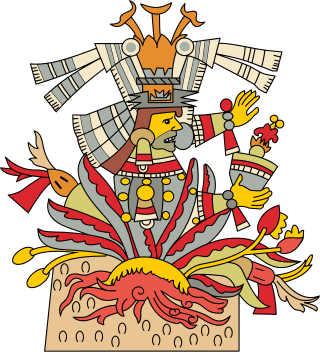
Mayahuel is the female deity associated with the maguey plant among cultures of central Mexico in the Postclassic era of pre-Columbian Mesoamerican chronology, and in particular of the Aztec cultures. As the personification of the maguey plant, Mayahuel is also part of a complex of interrelated maternal and fertility goddesses in Aztec religion and is also connected with notions of fecundity and nourishment.

Huitzilopochtli is the solar and war deity of sacrifice in Aztec mythology. He was also the patron god of the Aztecs and their capital city, Tenochtitlan. He wielded Xiuhcoatl, the fire serpent, as a weapon, thus also associating Huitzilopochtli with fire.
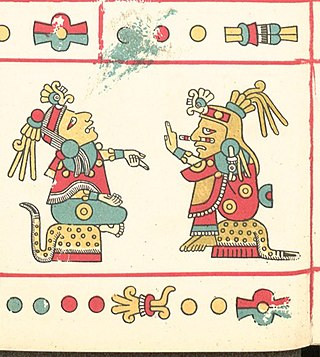
Ōmeteōtl is a name used to refer to the pair of Aztec deities Ometecuhtli and Omecihuatl, also known as Tōnacātēcuhtli and Tonacacihuatl. Ōme translates as "two" or "dual" in Nahuatl and teōtl translates as "god". The existence of such a concept and its significance is a matter of dispute among scholars of Mesoamerican religion. Ometeotl was one as the first divinity, and Ometecuhtli and Omecihuatl when the being became two to be able to reproduce all creation
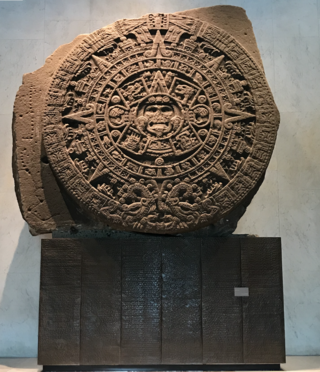
The Aztec or Mexica calendar is the calendrical system used by the Aztecs as well as other Pre-Columbian peoples of central Mexico. It is one of the Mesoamerican calendars, sharing the basic structure of calendars from throughout ancient Mesoamerica.

The Nahuas are a group of the indigenous people of Mexico, El Salvador, Guatemala, Honduras, and Nicaragua. They comprise the largest indigenous group in Mexico and second largest in El Salvador. The Mexica (Aztecs) were of Nahua ethnicity, and the Toltecs are often thought to have been as well, though in the pre-Columbian period Nahuas were subdivided into many groups that did not necessarily share a common identity.

Miguel León-Portilla was a Mexican anthropologist and historian, specializing in Aztec culture and literature of the pre-Columbian and colonial eras. Many of his works were translated to English and he was a well-recognized scholar internationally. In 2013, the Library of Congress of the United States bestowed on him the Living Legend Award.
Classical Nahuatl is any of the variants of Nahuatl spoken in the Valley of Mexico and central Mexico as a lingua franca at the time of the 16th-century Spanish conquest of the Aztec Empire. During the subsequent centuries, it was largely displaced by Spanish and evolved into some of the modern Nahuan languages in use today. Although classified as an extinct language, Classical Nahuatl has survived through a multitude of written sources transcribed by Nahua peoples and Spaniards in the Latin script.

Aztec society was a highly complex and stratified society that developed among the Aztecs of central Mexico in the centuries prior to the Spanish conquest of the Aztec Empire, and which was built on the cultural foundations of the larger region of Mesoamerica. Politically, the society was organized into independent city-states, called altepetls, composed of smaller divisions (calpulli), which were again usually composed of one or more extended kinship groups. Socially, the society depended on a rather strict division between nobles and free commoners, both of which were themselves divided into elaborate hierarchies of social status, responsibilities, and power. Economically the society was dependent on agriculture, and also to a large extent on warfare. Other economically important factors were commerce, long-distance and local, and a high degree of trade specialization.
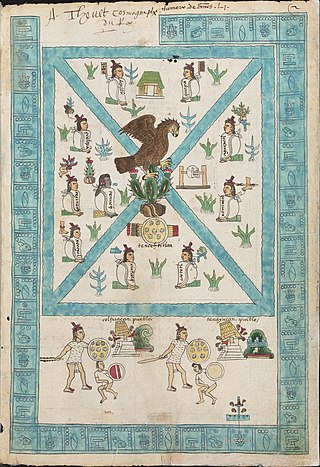
Aztec codices are Mesoamerican manuscripts made by the pre-Columbian Aztec, and their Nahuatl-speaking descendants during the colonial period in Mexico.

The Spanish conquest of the Aztec Empire, also known as the Conquest of Mexico or the Spanish-Aztec War (1519–21), was one of the primary events in the Spanish colonization of the Americas. There are multiple 16th-century narratives of the events by Spanish conquistadors, their indigenous allies, and the defeated Aztecs. It was not solely a contest between a small contingent of Spaniards defeating the Aztec Empire but rather the creation of a coalition of Spanish invaders with tributaries to the Aztecs, and most especially the Aztecs' indigenous enemies and rivals. They combined forces to defeat the Mexica of Tenochtitlan over a two-year period. For the Spanish, the expedition to Mexico was part of a project of Spanish colonization of the New World after twenty-five years of permanent Spanish settlement and further exploration in the Caribbean.

The history of chocolate began in Mesoamerica. Fermented beverages made from chocolate date back to at least 1900 BC to 1500 BC. The Mexica believed that cacao seeds were the gift of Quetzalcoatl, the god of wisdom, and the seeds once had so much value that they were used as a form of currency. Originally prepared only as a drink, chocolate was served as a bitter liquid, mixed with spices or corn puree. It was believed to be an aphrodisiac and to give the drinker strength. Today, such drinks are also known as "Chilate" and are made by locals in the south of Mexico and the north triangle of Central America. After its arrival to Europe in the sixteenth century, sugar was added to it and it became popular throughout society, first among the ruling classes and then among the common people. In the 20th century, chocolate was considered essential in the rations of United States soldiers during war.
Teotl is a Nahuatl term for sacredness or divinity that is sometimes translated as "god". For the Aztecs teotl was the metaphysical omnipresence upon which their religious philosophy was based.

The Mexica were a Nahuatl-speaking indigenous people of the Valley of Mexico who were the rulers of the Mexica Empire. The Mexica established Tenochtitlan, a settlement on an island in Lake Texcoco, in 1325. A dissident group in Tenochtitlan separated and founded the settlement of Tlatelolco with its own dynastic lineage. In 1521, they were conquered by an alliance of Spanish conquistadors and indigenous people including the Tlaxcaltecs led by Hernán Cortés.
New Philology generally refers to a branch of Mexican ethnohistory and philology that uses colonial-era native language texts written by Indians to construct history from the indigenous point of view. The name New Philology was coined by James Lockhart to describe work that he and his doctoral students and scholarly collaborators in history, anthropology, and linguistics had pursued since the mid-1970s. Lockhart published a great many essays elaborating on the concept and content of the New Philology and Matthew Restall published a description of it in the Latin American Research Review. The techniques of the New Philology have also been applied in other disciplines such as European medieval studies.

Quetzalcoatl is a deity in Aztec culture and literature. Among the Aztecs, it was related to wind, Venus, Sun, merchants, arts, crafts, knowledge, and learning. It was also the patron god of the Aztec priesthood. It was one of several important gods in the Aztec pantheon, along with the gods Tlaloc, Tezcatlipoca and Huitzilopochtli. Two other gods represented by the planet Venus are Tlaloc and Xolotl.
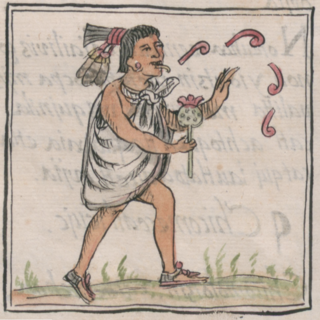
Nahuatl, Aztec, or Mexicano is a language or, by some definitions, a group of languages of the Uto-Aztecan language family. Varieties of Nahuatl are spoken by about 1.7 million Nahua peoples, most of whom live mainly in Central Mexico and have smaller populations in the United States.

A macuahuitl is a weapon, a wooden club with several embedded obsidian blades. The name is derived from the Nahuatl language and means "hand-wood". Its sides are embedded with prismatic blades traditionally made from obsidian. Obsidian is capable of producing an edge sharper than high quality steel razor blades. The macuahuitl was a standard close combat weapon.
References
- 1 2 "cuachtli. | Nahuatl Dictionary". nahuatl.uoregon.edu. Retrieved 6 February 2021.
- 1 2 3 Berdan, Frances F. (21 April 2014). Aztec Archaeology and Ethnohistory. Cambridge University Press. ISBN 978-1-107-72902-5 . Retrieved 5 February 2021.
- ↑ Carballo, David (2020). Collision of Worlds: A Deep History of the Fall of Aztec Mexico and the Forging of New Spain. Oxford University Press. p. 113. ISBN 978-0-19-086435-4.